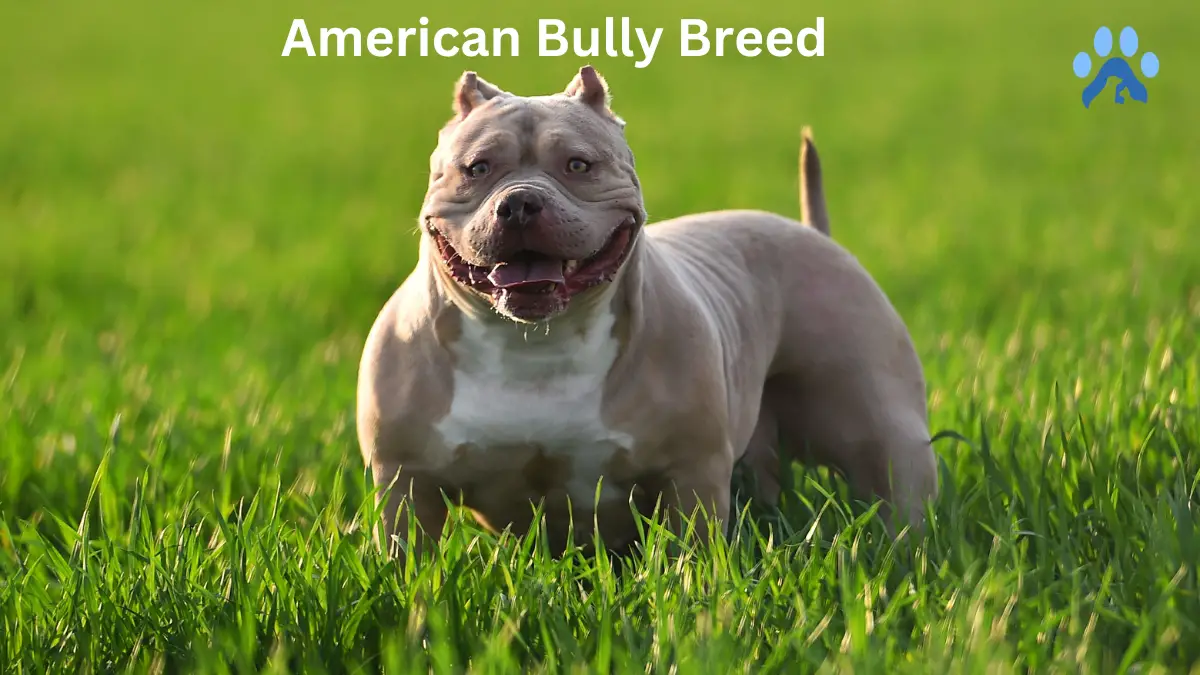The American Bully breed, a recent and popular addition to the canine world, has quickly gained attention for its affectionate nature and powerful appearance. Developed in the United States during the 1980s, the breed is a combination of American Pit Bull Terriers, American Staffordshire Terriers, and Bulldog-type breeds, resulting in a medium-sized dog that typically weighs between 30 to 70 pounds and stands around 16 to 20 inches tall. Although relatively new, the American Bully has already gained recognition from the United Kennel Club, adding to its appeal among dog enthusiasts.
As a comprehensive guide to the American Bully, this article aims to provide insightful and accurate information for both experienced and novice dog owners alike. To help readers understand the breed’s various characteristics, this guide will discuss its origin, temperament, physical traits, and types, including Standard, Pocket, and XL Bullies. By exploring the unique aspects of the American Bully, prospective and current owners can ensure they are equipped with the knowledge needed for a successful relationship with their beloved canine companion.
Definition of American Bully Breed
The American Bully is a relatively modern dog breed developed in the United States between the 1980s and 1990s. This breed was created by crossing American Pit Bull Terriers with American Staffordshire Terriers, and Bulldog-type breeds. The intention behind the development of this breed was to create a companion dog that is strong, confident, and adaptable to various settings. In 2004, the American Bully Kennel Club (ABKC) officially recognized and standardized the breed, followed by the European Bully Kennel Club (EBKC) in 2008, and finally, the United Kennel Club (UKC) in 2013.
The American Bully is a medium-sized breed, standing between 16 to 20 inches tall and weighing between 30 to 70 pounds. These dogs are known for their muscular build, blocky head, and sturdy physique. The breed can further be categorized into four main varieties: Pocket, Standard, Classic, and XL. These categories are based on specific height and weight ranges, as well as defining physical characteristics. However, all American Bully breeds share a strong and confident demeanor, making them excellent companions and family pets.
In conclusion, the American Bully is a versatile and powerful breed, characterized by its muscular build, blocky head, and confident demeanor. By understanding the breed’s history, physical traits, and temperament, potential owners can make informed decisions about whether the American Bully is the right companion for their lifestyle and needs.
History of the American Bully Breed
American Bully Dog Breed Origin
The American Bully is a relatively recent breed, originating in the United States between the 1980s and 1990s. Breeders on both the East and West coasts used a combination of American Pit Bull Terriers, American Staffordshire Terriers, American Bulldogs, Olde English Bulldogs, and English Bulldogs as their foundation stock. The goal was to create a companion dog breed with a muscular appearance and a friendly demeanor.
A Brief Discussion of the American Bully Breed’s Ancestors
The breed’s ancestors – the American Pit Bull Terrier, American Staffordshire Terrier, American Bulldog, Olde English Bulldog, and English Bulldog – each contributed respective traits to the American Bully.
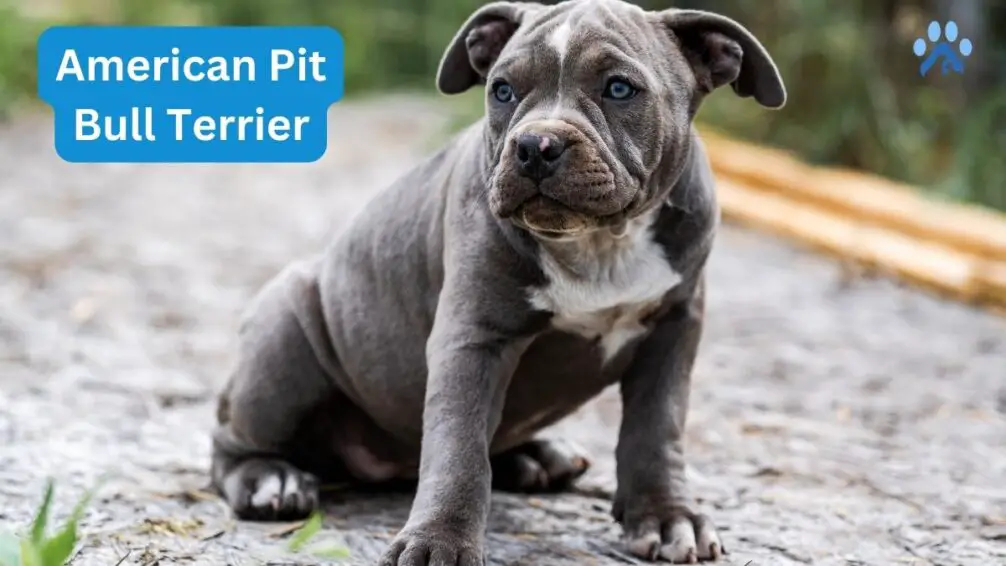

The American Pit Bull Terrier and American Staffordshire Terrier both have a history as working dogs, often used in dog sports and guarding tasks. They are known for their strength and tenacity.
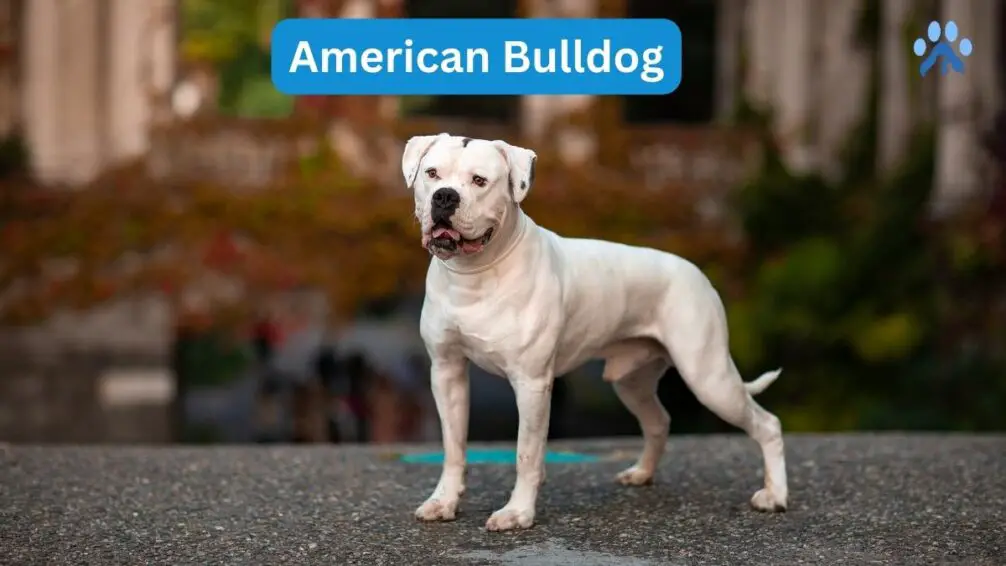
The American Bulldog is a versatile breed that historically served as a working farm dog, performing various tasks such as hunting, guarding, and herding. This breed is known for its athleticism and loyalty.

The Olde English Bulldog is a powerful and muscular dog that originated in England. Originally bred for bull-baiting, the breed has evolved into a devoted family pet, known for its courage and affectionate nature.

The English Bulldog has a distinctive and iconic appearance featuring a compact body and a wide, wrinkled face. Known for their calm and gentle temperament, this breed has become a popular family companion over time.
Evolution of the American Bully Breed Over Time
The American Bully breed has evolved since its inception, mainly due to selective breeding. The breed was first officially recognized by the American Bully Kennel Club (ABKC) in 2004, and later by the European Bully Kennel Club (EBKC) in 2008. The United Kennel Club (UKC) gave official recognition to the American Bully breed on July 15, 2013.
Over time, the American Bully breed has developed various types, ranging in size and appearance. These types include Classic, Pocket, Standard, and XL, each with its unique characteristics reflecting different aspects of the breed’s ancestral traits.
Throughout its history, breeders have focused on cultivating a stable and friendly temperament in the American Bully, making it a popular choice among dog enthusiasts today. Emphasis has also been placed on maintaining the breed’s strong, muscular appearance while enhancing its suitability as a loving family companion.
In conclusion, the American Bully breed, though relatively new, has a fascinating history rooted in the United States’ dog breeding community. Its diverse range of ancestors and the selective breeding process have led to the emergence of a breed known for its unique appearance, strength, and friendly nature. Today, the American Bully continues to grow in popularity, serving as a faithful companion and a testament to the ingenuity of dog breeders.
The Appearance of the American Bully Breed
Body Type
The American Bully breed is known for its compact, strong, and thick-set body structure. It’s muscular build and stocky appearance come from its foundation in the American Pit Bull Terrier, blended with other bull breeds. They possess a solid frame, wide chest, and well-conditioned muscles, contributing to their overall power and agility.
Head Type
American Bullies have a distinct blocky head shape, with a broad skull and well-defined cheeks. Their medium-sized eyes are set wide apart and display an intelligent and alert expression. Despite their strong head, they have floppy ears that can be cropped if desired, while their muzzle is usually wide and square with a clean scissor bite.
Coat Type
The coat of an American Bully is short and smooth, fitting tightly to their muscular body structure. The breed’s short coat makes grooming simple and guarantees low shedding.
Physical Characteristics
- Height: Males typically measure between 17 and 20 inches tall, while females stand between 16 and 19 inches at the shoulders.
- Weight: The weight varies depending on the specific type of American Bully, but they generally weigh between 70 and 120 pounds.
- Colors: American Bullies come in a variety of colors, including but not limited to black, white, brindle, fawn, blue, and chocolate.
Variations
There are four main types of American Bullies: Standard, Pocket, XL, and Classic. The differences between them lie mainly in their size and structure, but all types share the same temperament and breed characteristics.
Life Span
American Bullies have a relatively long life span for a breed of their size. They usually live between 10 to 13 years, but proper care, nutrition, and exercise can contribute to a longer and healthier life.
Litter Size
The number of puppies in an American Bully litter can vary, but on average, these dogs produce litters of about five to eight puppies.
American Bully Traits
The American Bully breed has captivated pet owners and dog enthusiasts with its loyal, loving personality and muscular build. In this section, we will explore the different types of American Bullies, their strength, and the various life stages they go through.
Types of American Bully
There are several types of American Bullies, which vary in size and physical appearance. The main types are:
- Standard American Bully: Medium to large-sized, with a compact and muscular body. Males typically stand 17″-20″ tall, while females are 16″-19″. Their blocky heads and confident stance give an impression of strength.
- Pocket American Bully: A smaller version of the Standard, with the same muscular build and personality.
- XL American Bully: As the name suggests, these are the largest of the breed, with the same characteristics as the Standard and Pocket types.
- Classic American Bully: This type exhibits a more toned-down appearance in terms of muscularity but still retains the breed’s lovable and loyal personality.
Strength – How Strong are American Bullies?
American Bullies are powerful and muscular dogs, which contributes to their strength. They have a high energy level and are quite athletic, making them great companions for various physical activities. It’s essential to note that, despite their strength, American Bullies are known for their gentle and amiable nature—especially when well-trained and socialized.
American Bully Life Stages
Just like any other dog breed, American Bullies go through several life stages. The breed has a life span of 10 to 13 years. The following are the key life stages of an American Bully:
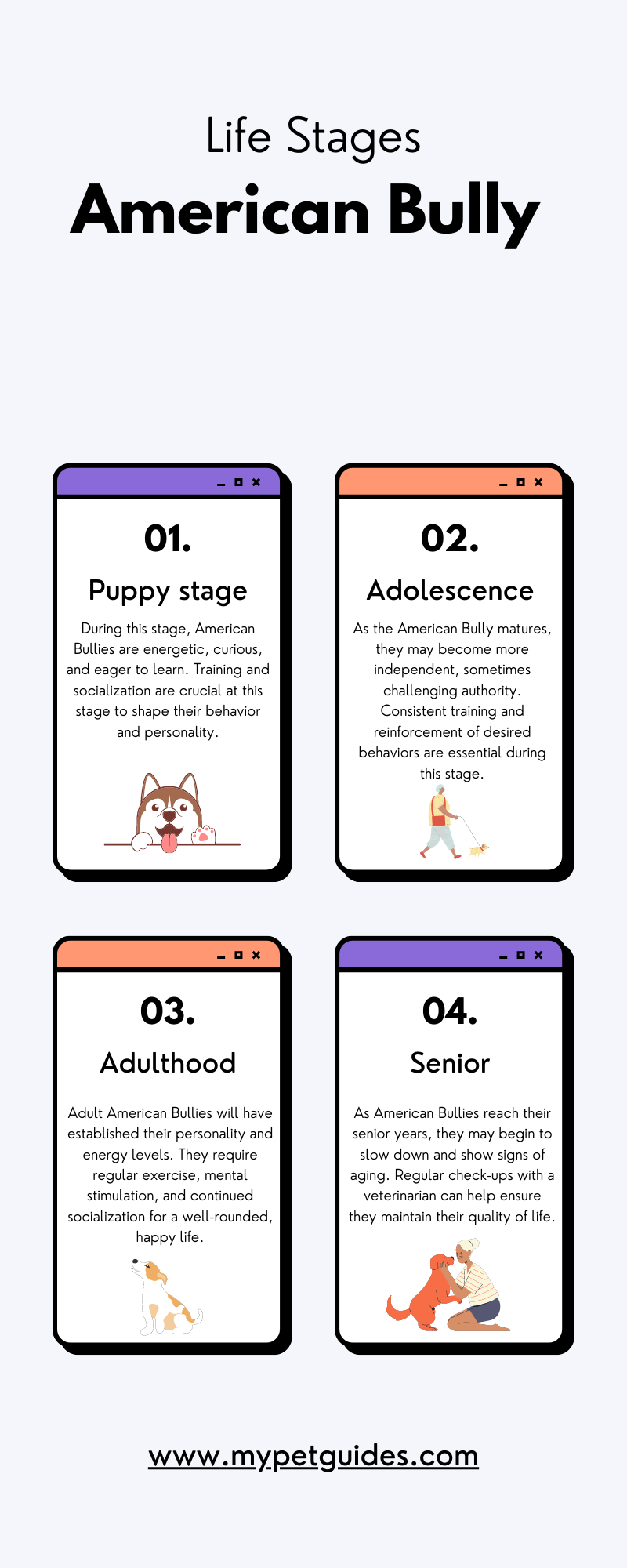
- Puppy stage: During this stage, American Bullies are energetic, curious, and eager to learn. Training and socialization are crucial at this stage to shape their behavior and personality.
- Adolescence: As the American Bully matures, they may become more independent, sometimes challenging authority. Consistent training and reinforcement of desired behaviors are essential during this stage.
- Adulthood: Adult American Bullies will have established their personality and energy levels. They require regular exercise, mental stimulation, and continued socialization for a well-rounded, happy life.
- Senior: As American Bullies reach their senior years, they may begin to slow down and show signs of aging. Regular check-ups with a veterinarian can help ensure they maintain their quality of life.
Understanding and catering to the specific traits, needs, and life stages of the American Bully will ensure a strong, lasting bond between you and your loyal companion. By doing so, you’ll have a pet that is both physically impressive and a loving addition to your family.
Temperament
When it comes to temperament, the American Bully is known for being friendly, sociable, and eager to please. They are typically good with children, making them a popular choice for families. However, it’s essential for dog owners to understand that the American Bully’s strong physique and energetic nature require regular exercise and mental stimulation to maintain a balanced and happy lifestyle. Training is crucial from an early age, using positive reinforcement methods and consistent boundaries to ensure a well-behaved and obedient companion.
Loyalty and Affection of the American Bully Breed
The American Bully breed is known for its loving and loyal temperament, making them great family pets. They form strong bonds with their families and are highly affectionate dogs. The more time spent together, the deeper the connection will become between the dog and its family members. Their loyalty and affection make them great protectors as well as companions.
Intelligence and Trainability of the American Bully Breed
These dogs possess a high level of intelligence, which makes them easier to train than some other breeds. Their eagerness to please their human companions, combined with their intelligence, makes them highly responsive to training. With consistent and positive reinforcement, these dogs can learn various commands, tricks, and even agility tasks. However, it is essential to remember that due to their strong and muscular build, they may require consistent and firm training to maintain a balanced temperament.
Importance of Socialization for Good Manners and Behavior
Early socialization is crucial for the American Bully breed to ensure their good behavior and manners. Exposure to various environments, humans, and other animals will help them develop confidence and resilience. As they are naturally social animals, it is essential to start the socialization process from a young age to help them become well-rounded and well-behaved adults. This will help prevent any potential behavioral issues that may arise due to fear or mistrust.
Compatibility of the American Bully Breed with Children and Other Pets
The American Bully breed is generally compatible with children and other pets, making them great family pets. Their friendly and sociable nature allows them to easily adapt to life with other pets in the household, including cats and other dogs. They are gentle and patient with children, enjoying their company and engaging in playful activities with them. However, as with any dog breed, it is important to supervise interactions between pets, especially when introducing them to younger children or less familiar animals.
By understanding and embracing the American Bully breed’s temperament, intelligence, and sociability, families can fully enjoy the unique companionship and loyalty these dogs offer. With proper socialization and training, this breed will become a loving and obedient family pet that is compatible with children and other pets alike.
Training and Exercise
High Trainability of the American Bully Breed
The American Bully is known for its high trainability, which is one of the factors that make them a popular choice among dog owners. These dogs are intelligent, eager to please, and respond well to training. An American Bully’s willingness to learn new commands and behaviors makes them more likely to be obedient and well-mannered in various situations.
Positive Reinforcement Training Methods for American Bullies
Training an American Bully is most successful when using positive reinforcement methods that focus on rewarding good behavior, rather than punishing undesirable behavior. This approach helps to build a strong bond between the owner and dog, as well as minimize the chances of developing aggressive tendencies. Common positive reinforcement techniques include the use of treats, praise, and toys as rewards for exhibiting desired behaviors. Teaching basic commands such as “sit,” “stay,” “come,” and “leave it” from an early age can contribute significantly to a well-trained and happy American Bully.
Exercise Requirements of the American Bully Breed
Due to their muscular and energetic nature, American Bullies require frequent exercise to maintain their physical health and overall well-being. Activities that help them burn energy and build muscle tone are especially beneficial, such as daily walks, jogs, or playing fetch. Regular exercise not only contributes to their physical health but also helps in teaching discipline and obedience.
Various Activities and Games American Bullies Enjoy
There are various activities and games suitable for American Bullies to enjoy and fulfill their exercise needs. Some of these activities include:
- Fetch: A simple yet effective way for American Bullies to expend energy while engaging their natural instincts to chase and retrieve objects.
- Tug-of-war: This game helps to strengthen their muscles and provides mental stimulation, as long as it is played with proper supervision and control.
- Agility courses: American Bullies can benefit from learning how to navigate through obstacles, which helps to improve physical coordination and mental focus.
- Socialization: Taking the dog to off-leash dog parks or arranging playdates with other dogs can help develop essential social skills and provide a well-rounded, outgoing temperament.
In conclusion, a well-trained American Bully with regular exercise, socialization activities, and positive reinforcement techniques can lead to a strong and healthy bond between the dog and its owner. By understanding the specific needs and capabilities of the breed, owners can ensure a happy, confident, and well-behaved American Bully.
Grooming
Grooming Requirements for American Bullies
American Bullies are a low-maintenance breed when it comes to grooming. Their short coat makes it simple to care for them and does not require intensive brushing or frequent visits to a professional groomer. However, regular grooming practices are still essential for maintaining their overall health and appearance. Key aspects of grooming for American Bullies include maintaining their coat, ears, and nails.
One of the primary grooming requirements for American Bullies is keeping their coat clean and healthy. Due to their short hair, they do not require frequent baths. It is generally recommended to bathe your American Bully once every 2-3 months or as needed, depending on factors such as their activity level and skin condition (source).
Additionally, monitoring and cleaning their ears is crucial for preventing infections and maintaining overall ear health. Regularly checking for dirt, wax, or any unusual discharge is vital, and gently cleaning their ears with a damp cloth or appropriate ear-cleaning solution can help maintain cleanliness.
Standard Grooming Practices for American Bullies
Adhering to some standard grooming practices can help keep your American Bully looking and feeling their best. Here are a few tips for maintaining proper grooming care:
Brushing: Use a soft-bristle brush or a grooming mitt to gently and regularly remove loose hair, dirt, and debris from their coat. This practice also helps distribute their natural oils, promoting healthy skin and a shiny coat.
Bathing: As mentioned earlier, bathe your American Bully once every 2-3 months or as needed, using a gentle shampoo designed specifically for dogs. Avoid over-bathing, as it can strip their skin and coat of natural oils, leading to dryness and irritation.
- Ear Care: Regularly inspect and clean their ears, as mentioned above. Be gentle and watch for signs of discomfort or any unusual discharge.
- Nail Care: Maintain your American Bully’s nails by trimming or filing them approximately once a month. Keeping nails at an appropriate length prevents discomfort, accidental injury, or complications when walking.
- Dental Care: To maintain your American Bully’s oral health, brush their teeth regularly using a dog-specific toothpaste and toothbrush. This can help prevent plaque build-up, gum disease, and bad breath.
Incorporating these standard grooming practices into your routine can help maintain your American Bully’s health, appearance, and overall well-being.
Health
Common Health Issues That Affect the American Bully Breed
Although the American Bully is generally a healthy breed, there are some health issues that can affect them. One of the more common problems is hip dysplasia, a genetic condition in which the hip joint doesn’t develop properly. This can lead to arthritis and pain in the affected dog. Other common health issues include:
- Obesity: Due to their muscular build, these dogs need a proper diet and exercise to maintain a healthy weight. Overfeeding can lead to obesity, which puts strain on joints and can lead to other health issues.
- Allergies: American Bullies are prone to skin allergies and irritations, which can make them uncomfortable and cause skin infections if not addressed.
- Heart issues: Some American Bullies may develop heart problems, such as heart murmurs or cardiomyopathy, which can reduce their lifespan if not managed well.
Preventative Measures for the Health of American Bullies
To ensure the best health for your American Bully, it’s essential to take some preventative measures:
- Regular vet check-ups: Taking your dog for routine veterinary check-ups can help detect any health issues early and start treatment sooner.
- Proper diet and exercise: Feeding your American Bully a balanced diet that includes all the necessary nutrients, vitamins, and minerals is essential for their overall health. Ensuring they get the right amount of exercise can also help prevent obesity and maintain strong muscles and joints.
- Commitment to grooming and skin care: Regular grooming and checking your dog’s skin for signs of irritation or infection can help prevent and address allergies.
- Monitoring weight and joint health: Keep an eye on your dog’s weight and be proactive in addressing any signs of joint issues, such as limping or difficulty moving. This can be done by adjusting their diet or consulting your vet for further guidance.
- Responsible breeding: If you plan on breeding your American Bully, ensure that you follow responsible breeding practices to reduce the risk of passing on genetic health issues like hip dysplasia.
By following these preventative measures and maintaining a strong commitment to your American Bully’s health, you can help ensure they live a happy and healthy life.
Food Requirements of American Bully Dog Breed
Nutritional Requirements of the American Bully Breed
The American Bully, a popular breed of dog known for its muscular build and friendly personality, requires a balanced and nutritious diet to maintain its health and well-being. A proper diet ensures that the dog receives all the necessary nutrients, vitamins, and minerals needed for its overall health and development. For instance, they require a good balance of proteins, fats, and carbohydrates.
Protein is essential for the American Bully’s muscle growth and maintenance, as well as for providing energy. The recommended protein content in their diet should be around 22-28% for optimal health. High-quality animal sources like chicken, turkey, and fish are ideal.
Fats serve as an energy source, helping to maintain healthy skin, coats, and joints. Recommended fat content for American Bullies is about 15-18%. Sources of healthy fats include fish oil, flaxseed oil, and chicken fat.
Carbohydrates provide energy and contribute to the overall health of the digestive system. However, American Bullies don’t require a high carbohydrate content in their diet. Foods low in carbohydrates, such as sweet potatoes or brown rice, can be ideal options.
Healthy Food Options for American Bullies
When choosing the perfect dog food for your American Bully, it’s crucial to consider quality ingredients and a balanced nutritional profile. One option is a high-quality dry food formulated specifically for puppies, with the first five ingredients being deboned chicken, deboned turkey, flounder, eggs, and whole Atlantic mackerel.
For adult American Bullies, it’s essential to focus on their specific weight and activity level. Here are some guidelines on portions and healthy food options:
- Small Bullies (30-50 lbs): Feed about 1.5 to 2.5 cups of high-quality dry food daily, divided into two meals.
- Medium Bullies (50-70 lbs): Feed about 2.5 to 3.5 cups of high-quality dry food daily, divided into two meals.
- Large Bullies (70-90 lbs): Feed about 3.5 to 4.5 cups of high-quality dry food daily, divided into two meals.
Some healthy food options for American Bullies include:
- Grain-free kibble: High-quality grain-free kibble rich in protein and healthy fats ensure easy digestion and balanced nutrition.
- Raw diet: A raw diet, also known as a biologically appropriate raw food (BARF) diet, offers a more natural approach to nutrition, using raw meat, bones, fruits, and vegetables.
- Quality canned food: A mix of high-quality canned food alongside kibble can provide a balanced diet with variety and convenience.
Maintaining regular feeding schedules and close monitoring of your American Bully’s weight, activity levels, and health is vital to ensure appropriate nutrition and overall well-being.
Pros and Cons of Owning an American Bully Breed
Pros:
- American Bullies are incredibly loyal and affectionate, making them excellent family pets.
- They are known for their versatility and excel in various dog sports and activities.
- American Bullies have a strong presence and can provide a sense of security and protection.
Cons:
- Training and socialization are crucial due to their strong-willed nature.
- Breed-specific regulations may restrict ownership in some areas.
Popular American Bully Dog Breed Mixes
Bullypit: American Bully + American Pit Bull Terrier

This mix combines the strength and athleticism of the American Bully with the energy and agility of the American Pit Bull Terrier.
Bully Mastiff: American Bully + Mastiff
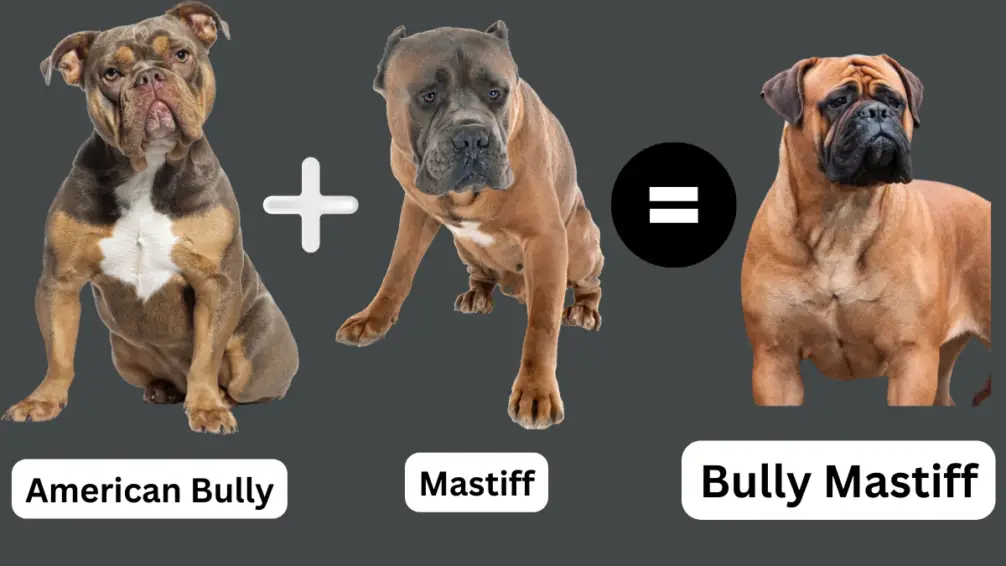
The Bully Mastiff mix results in a large and powerful dog, combining the muscular build of the American Bully with the size and strength of the Mastiff.
Bully Boxer: American Bully + Boxer
This mix brings together the friendly and playful nature of the Boxer with the muscular physique and protective instincts of the American Bully.
Bully Bulldog: American Bully + English Bulldog
The Bully Bulldog mix combines the strong and sturdy appearance of the English Bulldog with the athleticism and endurance of the American Bully.
Bully Shepherd: American Bully + German Shepherd
This mix combines the intelligence and loyalty of the German Shepherd with the muscular build and protective nature of the American Bully.
Bully Rottweiler: American Bully + Rottweiler
The Bully Rottweiler mix results in a powerful and protective dog, combining the loyalty and guarding instincts of the Rottweiler with the strength and agility of the American Bully.
Bully Lab: American Bully + Labrador Retriever
This mix combines the friendly and sociable nature of the Labrador Retriever with the muscular build and striking appearance of the American Bully.
Bully Husky: American Bully + Siberian Husky
The Bully Husky mix combines the endurance and agility of the Siberian Husky with the muscular physique and protective instincts of the American Bully.
Common Names for American Bully Breed
- Titan
- Diesel
- Luna
- King
- Bella
- Zeus
- Roxy
- Thor
- Ruby
- Rocky
- Daisy
- Ace
- Lola
- Bruno
- Mia
- Max
- Stella
- Rex
- Coco
- Duke
Tips for Choosing a Suitable Name for Your American Bully Breed
- Personality: Observe your dog’s personality traits, such as their energy level, temperament, and behavior. Consider names that reflect their unique personality, whether it’s playful, confident, or gentle.
- Appearance: Take note of your American Bully’s physical features, such as coat color, size, or distinctive markings. Names that relate to their appearance can be fitting and help showcase their individuality.
- Meaningful Names: Consider names with special meanings that resonate with you or hold personal significance. It could be a name inspired by a favorite book, movie character, or even a meaningful word in another language.
- Gender: Choose a name that aligns with your dog’s gender. Traditional gender-specific names can help avoid confusion and provide a clear identity for your American Bully.
- Short and Easy to Pronounce: Opt for a name that is short and easy to pronounce. This will make it easier for you, your family, and others to call your dog, especially during training sessions.
- Avoid Confusion: Choose a name that does not sound similar to common commands or cues used in training. This will help prevent confusion and ensure clear communication with your dog.
- Test It Out: Before settling on a name, try calling it out loud and see how your dog responds. Choose a name that your American Bully reacts positively to and seems to recognize.
- Family Input: Involve your family or household members in the naming process. Consider their suggestions and opinions to ensure everyone feels connected to the chosen name.
- Timeless and Age-Appropriate: Select a name that will remain suitable as your American Bully grows and ages. Avoid names that may become irrelevant or inappropriate as your dog matures.
- Trust Your Instincts: Ultimately, trust your instincts and choose a name that feels right to you and resonates with your American Bully’s personality and your connection with them.
Remember that the name you choose will become an integral part of your American Bully’s identity, so take your time and enjoy the process of naming your furry companion.
Where to Find American Bully Puppies for Sale
- Reputable breeders: Start by searching for reputable American Bully breeders in your area or in locations you’re willing to travel to. Many breeders have websites or social media pages where they advertise available puppies.
- Local classifieds: Check local newspapers or online classified websites for advertisements from breeders or individuals selling American Bully puppies. Be cautious and do thorough research to ensure the legitimacy and reputation of the sellers.
- Breed-specific clubs and organizations: Look for American Bully clubs or organizations in your region. These groups often have breeder directories or classified sections on their websites where you can find puppies for sale.
- Dog shows and events: Attend dog shows, exhibitions, or events specifically focused on American Bullies or general dog shows. You may find breeders or owners who have puppies available or can refer you to reputable breeders.
- Online platforms: Explore online platforms dedicated to pet sales, such as websites and forums that connect breeders and buyers. Be cautious when using online platforms and ensure you’re dealing with reputable sellers.
- Rescue organizations and shelters: Consider adopting an American Bully from a rescue organization or animal shelter. While it may be less common to find American Bully puppies in these places, it’s worth checking as there might be young dogs or adult dogs available for adoption.
- Networking: Reach out to local dog trainers, veterinarians, or American Bully enthusiasts in your area. They may have information about available puppies or be able to refer you to reputable breeders or sources.
Remember to do thorough research, ask for references, and visit the breeder or seller in person to ensure the health and well-being of the puppies before making a purchase. It’s important to prioritize the reputation and practices of the sellers to ensure you’re getting a healthy and well-socialized American Bully puppy.
Reputable Breeders and Adoption/Rescue Options for American Bully Breed
| Region | Country | Reputable Breeders | Adoption/Rescue Options |
|---|---|---|---|
| North America | United States | Los Angeles, California | American Bully Rescue (Texas) |
| Houston, Texas | Midwest Bully Buddies (Ohio) | ||
| Miami, Florida | Bully Paws Pit Bull Patriots (Virginia) | ||
| Chicago, Illinois | Long Island Bully Breed Rescue (New York) | ||
| Atlanta, Georgia | Pacific NW Pit Bull Rescue (Washington) | ||
| New York City, New York | |||
| Dallas, Texas | |||
| Phoenix, Arizona | |||
| Las Vegas, Nevada | |||
| San Francisco, California | |||
| Canada | Canada | Toronto, Ontario | Canadian Bully Rescue (Ontario) |
| Vancouver, British Columbia | |||
| Montreal, Quebec | |||
| Calgary, Alberta | |||
| Edmonton, Alberta | |||
| Ottawa, Ontario | |||
| Europe | United Kingdom | London | Bullies in Need (West Midlands) |
| Manchester | UK Bully Rescue (Staffordshire) | ||
| Birmingham | South Coast Bully Breed Rescue (Hampshire) | ||
| Glasgow | Birmingham Bully Rescue (West Midlands) | ||
| Leeds | |||
| Liverpool | |||
| Germany | Germany | Berlin | |
| Munich | |||
| Frankfurt | |||
| Hamburg | |||
| Cologne | |||
| Stuttgart | |||
| France | France | Paris | |
| Marseille | |||
| Lyon | |||
| Toulouse | |||
| Nice | |||
| Australia | Australia | Sydney | Australian Bully Rescue (Queensland) |
| Melbourne | Sydney Bully Friends Rescue (New South Wales) | ||
| Brisbane | Adelaide Bully Rescue (South Australia) | ||
| Africa | South Africa | Johannesburg | Pit Pals Bully Rescue (Gauteng) |
| Cape Town | Bull Terrier Rescue South Africa (Western Cape) | ||
| Durban | South African Bully Rescue (KwaZulu-Natal) |
Tips for Finding a Healthy and Well-Socialized American Bully Puppy
- Research reputable breeders: Start by researching and identifying reputable breeders who specialize in American Bullies. Look for breeders who prioritize the health, temperament, and well-being of their dogs.
- Visit the breeder in person: Once you’ve found potential breeders, arrange a visit to their facility or home. This allows you to assess the living conditions and see how the puppies and adult dogs are cared for. Look for clean and spacious areas with proper socialization opportunities.
- Observe the puppies’ behavior: Spend time observing the puppies’ behavior and interactions with each other and their mother. Well-socialized puppies should be curious, playful, and approachable. They should show no signs of fear, aggression, or excessive shyness.
- Check health clearances: Responsible breeders will conduct health screenings and provide clearances for common health issues affecting the American Bully breed. Request documentation for health clearances, such as hip and elbow evaluations, cardiac exams, and genetic tests for specific conditions.
- Meet the parents: Ideally, both the mother and father of the puppies should be available for you to meet. Observe their temperament, as it can give you an indication of the puppies’ future behavior. Healthy and well-socialized parents are more likely to produce offspring with similar qualities.
- Ask about socialization efforts: Inquire about the breeder’s socialization efforts. Puppies should be exposed to various stimuli, such as different sounds, surfaces, objects, and people. Proper socialization during the early weeks of life is crucial for their long-term behavior and adaptability.
- Request references: Ask the breeder for references from previous puppy buyers. Contact these individuals to inquire about their experience with the breeder and the temperament and health of their puppies.
- Review the paperwork: Ensure that the breeder provides you with proper documentation, including health records, registration papers, and a sales contract. The contract should outline the breeder’s health guarantee, return policy, and any additional terms and conditions.
- Consider breed-specific clubs and events: Attend American Bully events, such as dog shows or local breed club meetings. These gatherings allow you to meet experienced owners, breed enthusiasts, and reputable breeders who may be able to offer recommendations or point you in the right direction.
Remember, acquiring a healthy and well-socialized American Bully puppy requires patience and thorough research. Take your time, ask questions, and choose a breeder who prioritizes the welfare of their dogs.

